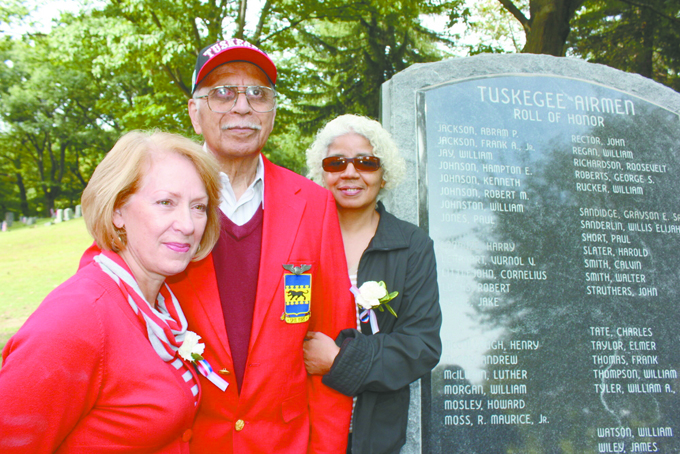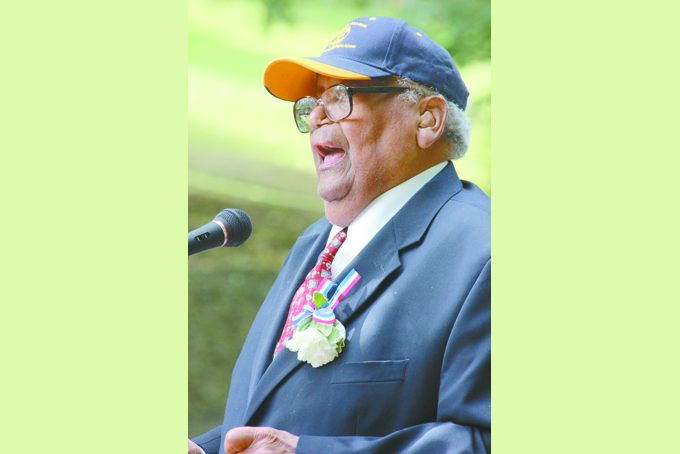
PROUD MOMENT—Airman Dr. Harry Lanauze stands proudly with wife, Helen, and daughter, Karlyn Coward, after viewing the list of names on the roll of honor. (Courier Photos/J.L. Martello)
by Genea L. Webb
For New Pittsburgh Courier
James A. Cotten sees the three and a half years he served as a Tuskegee Airmen as the best time of his life.
“During that time I learned to contribute to the betterment of the United States,” said Cotten who, according to his wife, Oteria, was drafted into the service when he turned 18.
On the recommendation of then-president Franklin Roosevelt, an all Black flight training program was created at the Tuskegee Institute and the Tuskegee Army Airfield in Alabama. The airmen belonged to the 332nd Fighter Group’s 99th, 100th, 301st and 302nd Fighter Squadrons and took part in more than 15,500 sorties in Europe, North Africa and Sicily. The Tuskegee Airmen were the first African-American military aviators in the United States armed forces.
“We were just doing what we were told to do,” said airmen Harold Slater, who grew up in the Hill District. “That’s what helped us get through the ordeal (of segregation and mistreatment) we paid our dues but we were able to help keep America safe.”

DEDICATED TO PROJECT—Regis D. Bobonis Sr., who founded and currently chairs the Tuskegee Airmen Memorial project, delivers opening remarks.
Upon returning stateside, the men dealt with much of the same racial prejudice that they encountered during the war.
Now, more than 24,000 days since the end of World War II, the airmen have finally received the honors they deserve with the creation of Tuskegee Airmen Memorial of the Greater Pittsburgh Region Inc.
It is the largest Tuskegee Airmen memorial in the country and is the centerpiece of an educational and commemoration project of the Tuskegee Airmen Memorial.
The memorial commemorates the legacy of almost 100 Tuskegee Airmen who originated from western Pennsylvania. The Tuskegee Airmen became one of the most decorated air squadrons during World War II, proving that African-American pilots could skillfully fly military combat aircrafts.
“Identifying the airmen from Western PA proved to be more difficult than imagined since military records were nonexistent,” said Regis D. Bobonis who founded and currently chairs the Tuskegee Airmen Memorial project. “Oftentimes the descendents of Tuskegee Airmen were themselves unaware of their parents’ service since many rarely even discussed their wartime experience.”
Located on a plaza composed of various concrete applications, the memorial consists of four large monuments two of which are engraved with the names of the western Pa airmen, a striking 10-foot high Red Tail monument. A bronze relief depicts the busts of several area airmen and a replica of the P-51 Red Tail is located on the large center monument.
“This is a glorious day. My heart is filled with joy,” said Elaine Effort whose father, the late Vurnol V. Leaphart of Homestead, served as one of the Tuskegee Airmen.
All granite monuments are from quarries in the United States operated by Rock of Ages of Vermont. Funding for the $300,000 memorial was made possible in part by a grant from Allegheny County, individual and organizational contributions and fundraisers. Additional in-kind support was provided by the Sewickley Cemetery, Rome Monument, Solomon Architect & Design and the borough of Sewickley.
“This monument memorializes and celebrates the legacy of these men and women who fought courageously to defend our freedom and the civil rights for African-Americans,” said John Dioguardi of Rome Monument. “Working on this project has educated me on the heroic actions of the soldiers who hailed from western Pennsylvania and excelled in combat while facing prejudice and discrimination.”
Opportunities for individual, corporate and organizational sponsorship are still available. Contact Rich Dieter at rcdieter@verizon.net to donate or to learn more.
“I believe this is long overdue,” said William Hicks who now resides in North Carolina but was born and raised in Homewood. He served as a Tuskegee Airmen for three and a half years. “It was an honor to serve.”
“It’s real rewarding to see what we accomplished back then. Had it not been for the airmen, World War II would’ve lasted longer and had it not been segregated, someone else would have taken the credit for what we earned. In that way, segregation was helpful,” Hicks said.